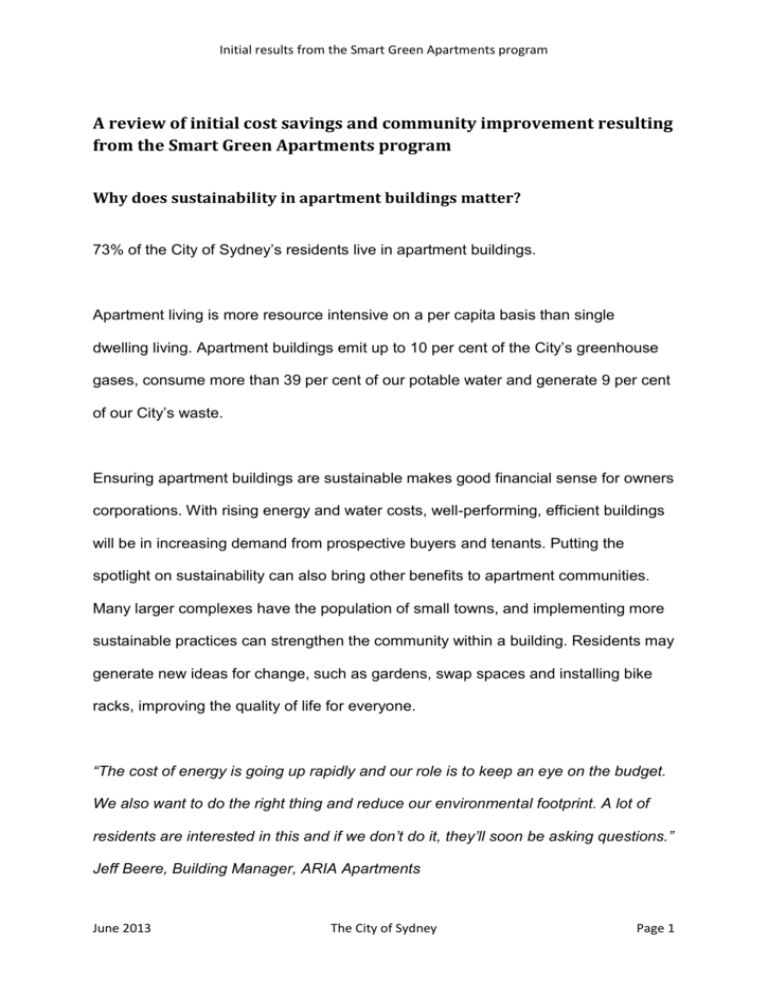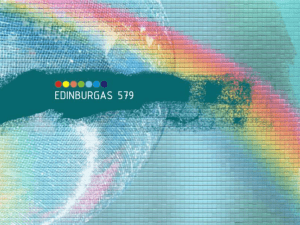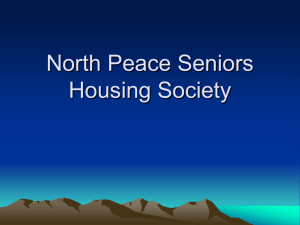Allan Hoy, Building Manager, Hyde Park Towers
advertisement

Initial results from the Smart Green Apartments program A review of initial cost savings and community improvement resulting from the Smart Green Apartments program Why does sustainability in apartment buildings matter? 73% of the City of Sydney’s residents live in apartment buildings. Apartment living is more resource intensive on a per capita basis than single dwelling living. Apartment buildings emit up to 10 per cent of the City’s greenhouse gases, consume more than 39 per cent of our potable water and generate 9 per cent of our City’s waste. Ensuring apartment buildings are sustainable makes good financial sense for owners corporations. With rising energy and water costs, well-performing, efficient buildings will be in increasing demand from prospective buyers and tenants. Putting the spotlight on sustainability can also bring other benefits to apartment communities. Many larger complexes have the population of small towns, and implementing more sustainable practices can strengthen the community within a building. Residents may generate new ideas for change, such as gardens, swap spaces and installing bike racks, improving the quality of life for everyone. “The cost of energy is going up rapidly and our role is to keep an eye on the budget. We also want to do the right thing and reduce our environmental footprint. A lot of residents are interested in this and if we don’t do it, they’ll soon be asking questions.” Jeff Beere, Building Manager, ARIA Apartments June 2013 The City of Sydney Page 1 Initial results from the Smart Green Apartments program The Smart Green Apartments Program The City’s Smart Green Apartments program aims to create more efficient costeffective buildings, with a focus on energy and water efficiency and waste reduction. The City has been working with executive committees, building managers and strata managers of thirty buildings, with each building receiving a; • comprehensive energy audit from the Office of Environment and Heritage’s Energy Saver program with costed recommendations and clear payback periods • water management plan • waste and recycling assessment As sustainability projects are implemented, data and learnings will be shared to help other apartment buildings in the City improve their efficiency. “We’ve actually done better than the program’s savings forecast. From February 2011 to March 2013 we’ve reduced our energy consumption by more than 30 per cent… Anyone who doesn’t do this is crazy!” Allan Hoy, Building Manager, Hyde Park Towers Energy Depending on the size of the block, up to 60 per cent of a building’s energy use can come from common property and equipment. June 2013 The City of Sydney Page 2 Initial results from the Smart Green Apartments program “The biggest surprise was finding out how much electricity lights use.” Rob Goodall, Executive Committee Chairperson, Signature Apartments On average, energy savings of up to 30 per cent were identified across the buildings in the program, potentially reducing carbon outputs by one third. Possible areas of savings included: • lighting retrofits, including controls and sensors • efficiency upgrades to pool heating systems and covers • variable speed drives on pumps and fans • grid connected solar photovoltaic In deciding which changes to implement first, most apartments looked for the best return on investment – with common area lighting usually being the first change made. In many cases, these had a payback period of two years or less. “We’d already started looking at monitoring our electricity use but the audit gave us a much better picture. To have that information from an independent source is really important when you want approval to make changes.” Christine Byrne, Former Executive Committee Chairperson, Parkridge Apartments “We changed our car park lights from T8 tubes to T5, saving over $10,000 a year with a payback period of 1.3 years. We’re now looking at replacing our corridor lights. We’ve found a company that will give us an Energy Savings Certificate rebate in advance, dramatically reducing the costs of the corridor June 2013 The City of Sydney Page 3 Initial results from the Smart Green Apartments program lights. We were expecting to spend $25,000 on them, but it will only be $6,000 – reducing the payback period from 2 1/2 years to 4 1/2 months. It’s a no-brainer.” Jeff Beere, Building Manager, Aria Apartments “By changing our fire stair lights to multi-function sensor lights, our power consumption in this area has gone down 82%.” Allan Hoy, Building Manager, Hyde Park Towers “We have a 25 metre pool that’s open and heated by gas all year. The bills were getting larger and larger. We could show the massive rise in bills and this led to a resolution not to heat the pool for the coldest three months of the year. This led to a drop in our gas bills by up to two-thirds.” Jan Craney and Janet Donald, Executive Committee, Glebe Gardens Other options for communal pools include replacing pumps and motors with more efficient equipment, and improving efficiencies on hot water systems. “We’re now looking at a solar pre-heat system for our hot water, where the water is taken to a certain temperature before it goes to the boilers.” Colin Volkofsy, Building Manager, Crown Gardens Water June 2013 The City of Sydney Page 4 Initial results from the Smart Green Apartments program Almost 90 per cent of the water consumed in each building occurs within apartments. Showers account for close to 40 per cent, and baths, toilets, bathroom basins and leaks are collectively responsible for another 30 per cent of total water use. Lack of individual water metering means there’s little incentive to use less, unless this is actively encouraged. In order to do this, the owners corporation of Parkridge Apartments paid for Sydney Water’s WaterFix program to fit more efficient showerheads in each of the apartments in the building. Over-crowding can also be a significant factor for buildings with high water use. Recommendations included promoting water-wise practices and installing sub-metering to try and get a better picture of higher use areas. Table: Average water use in apartment buildings Area of use Per cent of total Pool and spa 0.7% Irrigation 0.7% Public area amenities 1.3% Dishwashers 2.0% Retail/commercial 2.7% Other 2.8% Baths 3.2% Cooling towers 3.7% Kitchen taps 6.3% Washing machines 8.6% Bathroom basins 8.7% Apartment toilets 10.1% June 2013 The City of Sydney Page 5 Initial results from the Smart Green Apartments program Leaks 10.3% Apartment showers 38.9% Total 100% “If people are very conscious of their water usage they will reduce it themselves. For others you have to find ways to make it easier for them.” Christine Byrne, Former Executive Committee Chairperson, Parkridge Apartments “The audit enabled us to divide the building into five different zones – the pool, the cooling tower and three different residential areas. It has let me monitor water use a little more closely.” Allan Hoy, Building Manager, Hyde Park Towers Waste Sydney’s existing landfills will be largely full by 2020 and any new facilities will be a long way from our city, making future general waste disposal more expensive. Recycling and diversion of organic waste is essential to reducing the amount of waste that goes to landfill. Participating buildings looked at the location and organisation of their bins and put up new signage to encourage recycling. This resulted in an increase in the volume of recycling, and less general waste going to landfill. Signature Apartments used its Facebook page to regularly remind people about recycling and upcoming e-waste collections. Aria Apartments set up a swap space for furniture and other household items encouraging reuse and recycling. June 2013 The City of Sydney Page 6 Initial results from the Smart Green Apartments program “Anything decent goes in a flash!” Jeff Beere, Building Manager, Aria Apartments Another building bought a car space to set up a recycling zone: “One of the things that really surprised me was how much clothing gets thrown out in garbage – it was staggering. We decided to build a recycling area in the building by buying back a car space. It will be where everyone can see it and will include a charity clothing bin and an e-waste area. It will mean there’s less bins being emptied but most importantly, it’s socially responsible.” Gordon Streight, Executive Committee Chairperson, Bauhaus “After introducing more recycling bins and putting new, multilingual signs to identify what should go into each bin we’ve gone from four large general waste bins to two large and two small –and they’re not nearly as full as they used to be.” Rob Goodall, Executive Committee Chairperson, Signature Apartments “The owner’s corporation have saved about $2,000 per annum after we replaced hired recycling bins with council bins.” Jeff Beere, Building Manager, Aria Apartments Other initiatives and learnings The Smart Green Apartments program also inspired other sustainability initiatives. June 2013 The City of Sydney Page 7 Initial results from the Smart Green Apartments program Aria Apartments put in bike racks, which are now always full, and will soon be putting in more. At Signature Apartments, a gardening group has not only improved the common areas, it’s strengthened the sense of community. “We created a gardening group within the building. It’s a great way to meet other people – one lady who had come here from New Zealand said it really helped her settle into Sydney.” Rob Goodall, Executive Committee Chairperson, Signature Apartments Getting owners corporation approval and keeping residents informed. Implementing changes in common areas is usually met with little resistance from the owners corporation once the financial benefits were seen. Several of the buildings obtained pre-approval from owners corporations to make changes that would pay back in under 2 to 3 years, removing the need to present everything on a case-bycase basis. All of the buildings made sure they kept residents informed of the sustainability initiatives happening in their building. Methods used included lift notices, Facebook pages, and website information to let owners and tenants know what changes were happening, why, and the expected benefits. “You just need to have patience. Meetings and approvals for strata buildings run on their own timetable and decisions can take a long time.” Rob Goodall, Executive Committee Chairperson, Signature Apartments June 2013 The City of Sydney Page 8 Initial results from the Smart Green Apartments program How to get started Do your research and seek advice from other buildings Monitor and present utility consumption and costs to owners committees with the use of graphs and spread sheets Consider getting pre-approval for all changes that have a payback period of two years or less Resources greenstrata.com.au An information rich resource with tips and case studies for sustainable strata living. Energy smartblocks.com.au A national program helping apartment owners and their managers save money by improving energy efficiency in the common areas of their apartment buildings. The program includes an interactive online toolkit which guides people through the steps of scoping a project and getting it approved. Water greenstrata.com.au/category/water Waste cityofsydney.nsw.gov.au/live/waste-and-recycling Information on the City’s waste and recycling June 2013 The City of Sydney Page 9 Initial results from the Smart Green Apartments program • avoiding waste • collection days and bins • special collections and drop offs • recycling Strata skills workshops strataskills101.com.au Decisions on the management of common property within strata buildings can be complex and time consuming. The City has developed a series of workshops to provide new strata residents with tips and strategies Funding Energy audits for the Smart Green Apartments Program were subsidised by the Office of Environment & Heritage’s Energy Saver program. June 2013 The City of Sydney Page 10





